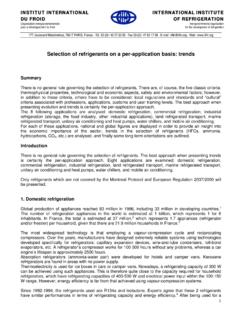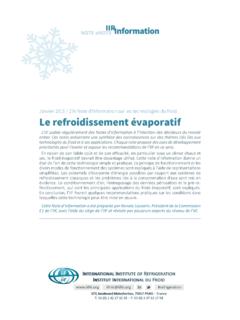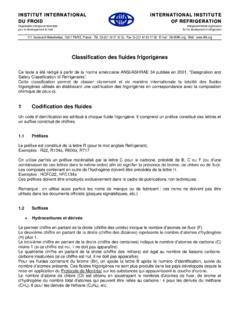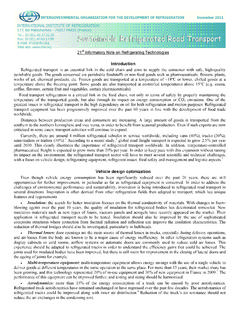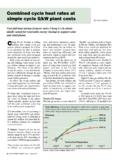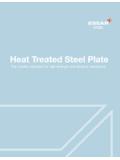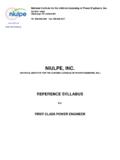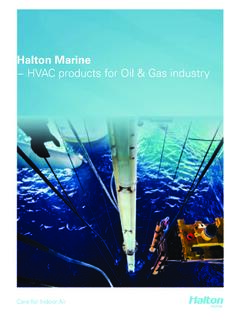Transcription of HOW TO IMPROVE ENERGY EFFICIENCY IN …
1 INSTITUT INTERNATIONAL DU FROID Organisation intergouvernementale pour le d veloppement du froid INTERNATIONAL INSTITUTE OF REFRIGERATIONI ntergovernmental organization for the development of refrigeration 177, boulevard Malesherbes, 75017 PARIS, France - Tel. 33-(0)1 42 27 32 35 - Fax 33-(0)1 47 63 17 98 - E-mail: - Web: November 2003 17th Informatory Note on Refrigerating Technologies How to IMPROVE ENERGY EFFICIENCY in refrigerating equipment Introduction Refrigeration is technology which makes a major contribution to humanity in many ways including food preservation, control of indoor air quality, gas liquefaction, industrial process control, production of food and drink and computer cooling. Without refrigeration, modern life would be impossible. About 15% of the world s electricity is used to drive refrigerating and air-conditioning systems.
2 Inefficient use of ENERGY is a waste of valuable resource and contributes to global warming. Most of the global warming effect of refrigerating systems comes from generating ENERGY to drive them. Only a small proportion comes from the release of certain refrigerants. This informatory note describes how the EFFICIENCY of refrigerating systems can be maximized thereby minimizing their global warming impact. Fundamentals Refrigeration is the science of making heat flow uphill from low to high temperatures. A refrigeration system extracts heat from the substance being refrigerated (cold reservoir) and rejects it to the ambient at a higher temperature (hot reservoir) as indicated in Figure 1. This is analogous to the pumping of water to an elevated storage tank. The ENERGY consumption of a refrigerator is roughly proportional to rate of heat extraction (amount of water pumped) and to the temperature lift through which the heat is raised (height water is pumped).
3 T e m p e r a t u r e Refrigerant Condensing Temperature TC Condenser Ambient Temperature (Hot Reservoir) Compressor Desired Substance Temperature (Cold Reservoir) Evaporator Refrigerant Evaporating Temperature T0 Figure 1. Schematic Diagram of Temperatures and heat Flows for a Refrigeration System The ENERGY EFFICIENCY of a refrigeration system is usually expressed as a Coefficient of Performance (COP) which is the ratio of the heat extraction rate to the rate of ENERGY use. Whatever type of refrigerating system is being used, it is fundamental to minimize the required heat extraction and to keep the difference between TC (condensing temperature) and T0 (evaporating temperature) as small as possible. Minimizing heat extraction is done by insulating the refrigerated room and low-temperature parts of the refrigeration system, minimizing ambient air infiltration ( door openings and leakage) and reducing ENERGY use in refrigerated applications ( fans and forklifts).
4 Reducing (TC T0) is done by maximizing condenser and evaporator heat transfer performance and minimizing refrigerant pressure drops in suction and discharge pipelines. Description of a Vapour Compression Refrigeration System The standard vapour compression refrigeration system consists of a refrigerant in a closed circuit comprising a compressor, a condenser, an expansion device, an evaporator and interconnecting piping (Figure 2). In the condenser, compressed refrigerant vapour at high pressure is condensed at high temperature by heat transfer to the surroundings. The high-pressure refrigerant liquid is reduced to a low pressure at the expansion valve. At low pressure, the refrigerant will evaporate at a low temperature enabling it to extract heat from the substance to be cooled. To complete the cycle, the low pressure refrigerant vapour exiting the evaporator is compressed to high pressure by the compressor.
5 The total heat rejected in the condenser is the sum of the heat extracted plus the compressor ENERGY use. CondenserExpansion deviceEvaporatorCompressorExtracted HeatRejected HeatEnergy in Figure 2. Schematic of a simple Vapour Compression Refrigeration System Loss of refrigerant from the circuit would have a very detrimental effect on the reliability of the system, so great care is taken to make refrigerating systems as leak-tight as possible. Individual domestic refrigerators, of which there are more than one billion, each contains a very small amount of refrigerant. Such systems are expected to run for more than 20 years without addition of refrigerant. The global warming effect of such refrigerators is significant but nearly all of it is caused by carbon dioxide produced when the electricity to run the refrigerator is generated.
6 Effect of System Components on EFFICIENCY Refrigerant Very few substances have properties appropriate for a refrigerant and, of these, few have stood the test of time and continue to be used as refrigerants. Figure 3 shows some of the substances that have been used as refrigerants and how their use has varied over time. 1850187519001925195019752000 AirWaterHFCsHCFCsCFCsAmmoniaHydrocarbons Carbon dioxide Figure 3. Typical Refrigerants and Their Historical Use There is no ideal refrigerant. Selection of a refrigerant is a compromise between many factors including ease of manufacture, cost, toxicity, flammability, environmental impact, corrosiveness and thermodynamic properties as well as ENERGY EFFICIENCY . A key characteristic is the pressure/temperature relationship. In general, for ENERGY EFFICIENCY it is desirable for the refrigerant critical point (temperature above which the refrigerant cannot condense) to be high compared with the heat extraction and rejection temperatures.
7 Good transport and heat transfer properties are also important for ENERGY EFFICIENCY as they reduce running costs and allow smaller temperature differences to be employed in evaporators and condensers and hence smaller overall temperature lifts. In general, refrigerants of low molecular weight and low viscosity will have the best properties. Compressor Compressors will lose EFFICIENCY if the temperature lift is higher than necessary and they will also lose EFFICIENCY if droplets of refrigerant liquid are present in the suction vapour or if the suction vapour becomes too hot. Compressor maintenance, where possible, and the preservation of lubricant quality are important to retain ENERGY EFFICIENCY . For some compressor types (particularly screw and centrifugal), their part-load ENERGY EFFICIENCY performance is poor compared with at full load, so sustained part-loaded operation should be avoided.
8 Variable speed drive technology and improved control systems can minimize the ENERGY penalty but increase capital costs. Condenser To keep refrigerant heat rejection temperatures as low as possible, condenser heat transfer rates should be maximized and the cooling medium temperature minimized. Evaporative condensers are often the most efficient because they reject heat to the wet-bulb temperature of the ambient air. For instance, humid air at 25 C and 60% relative humidity has a wet-bulb temperature of 16 C. However, they require careful maintenance to avoid Legionella contamination. Water-cooled condensers combined with cooling towers also approach ambient wet-bulb temperature but there is an additional temperature difference to drive heat from the refrigerant into the water, so refrigerant heat rejection temperature is generally higher.
9 Water use can be excessive if a cooling tower is not used. Air-cooled condensers are usually the least efficient method as they reject heat to the air dry-bulb temperature, which is generally significantly higher than wet-bulb or water temperature. However, for small systems they are commonly used because they are cheap, simple and require little maintenance. It is important to keep all types of condenser clean and free from fouling. Condensers rejecting heat to atmosphere must be allowed plenty of fresh air and protected against any tendency for the air to re-circulate back to the condenser inlet. Systems that operate with refrigerant suction pressures less than atmospheric ( low temperature ammonia or air-conditioning with HCFC-123) should use purgers to remove non-condensables from the refrigerant.
10 Expansion devices Many expansion devices require significant pressure difference to allow proper operation. Therefore condensing pressure is often maintained at artificially high levels, even at low ambient temperatures. The biggest culprit in this respect is the conventional thermostatic expansion valve which is often selected because of its very low cost. One solution is to use electronically controlled expansion valves. Evaporators As for condensers, evaporators should be designed to operate at minimum economic temperature difference so that the refrigerant heat extraction temperature can be as high as possible for a given substance temperature. Increasing heat extraction temperature also reduces the size of the compressor required. As well as evaporator size, aspects such as refrigerant distribution, circuiting and velocity, use of enhanced surfaces, air speeds (for air coolers) can all significantly affect ENERGY EFFICIENCY .
